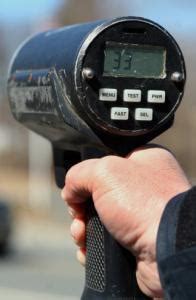How Do Speed Traps Work
Ronan Farrow
Mar 20, 2025 · 3 min read

Table of Contents
How Do Speed Traps Work? Understanding Speed Enforcement Technology
Speed traps, while often a source of frustration for drivers, play a crucial role in ensuring road safety. Understanding how they work can help you become a more informed and safer driver. This guide breaks down the various technologies used in speed enforcement, demystifying the process.
Types of Speed Detection Technology
Several technologies are employed by law enforcement to detect speeding vehicles. Here are some of the most common:
1. Radar Guns: The Classic Approach
Radar guns (radar stands for Radio Detection and Ranging) use radio waves to measure the speed of approaching and receding vehicles. The device emits a radio wave that bounces off the vehicle and returns to the gun. The difference in frequency between the emitted and returned wave is used to calculate the vehicle's speed. This method is effective at detecting speed from a distance, even with multiple vehicles on the road.
2. Lidar Guns: Precision Measurement
LIDAR (Light Detection and Ranging) uses laser beams instead of radio waves. LIDAR is more precise than radar and can target specific vehicles in heavy traffic. The laser beam measures the time it takes to reflect off the vehicle, providing an accurate speed reading. LIDAR is particularly effective in situations where radar might struggle, such as in poor weather conditions or when multiple vehicles are close together.
3. Average Speed Cameras: Monitoring Extended Stretches
Average speed cameras, often found on highways and long stretches of road, measure a vehicle's speed over a specific distance. They photograph the vehicle's license plate at the start and end points. The system then calculates the average speed. This method prevents drivers from simply slowing down at a specific point to avoid a radar or lidar gun.
4. In-Car Speed Detection Systems: Officer Safety & Efficiency
Modern police vehicles are often equipped with in-car speed detection systems. These systems integrate radar or lidar technology directly into the vehicle's computer system, making it easier for officers to detect speeding vehicles and collect evidence. This improves officer safety by minimizing the need to stop in traffic and enhances efficiency.
Factors Influencing Speed Trap Effectiveness
The effectiveness of a speed trap isn't solely based on the technology used. Several factors play a role:
- Visibility: Open and visible speed traps are often criticized for being revenue-generating rather than safety-focused. However, hidden speed traps can significantly impact driver behavior by encouraging consistent adherence to speed limits.
- Location: Speed traps placed in areas with high accident rates or near schools are seen as more justified than those positioned in seemingly arbitrary locations.
- Enforcement: Consistent enforcement is critical for a speed trap to be effective in changing driver behavior and reducing accidents.
Driving Safely and Avoiding Speeding Tickets
The best way to avoid a speeding ticket is to drive responsibly and adhere to posted speed limits. Familiarizing yourself with speed limits in various areas, allowing ample following distance, and consistently monitoring your speed are proactive ways to ensure your safety and avoid penalties.
Conclusion
Speed traps, using various technologies, aim to deter speeding and promote road safety. Understanding how these systems operate empowers drivers to make safe and informed choices on the road. Remember, safe driving is always the priority, irrespective of the presence or absence of speed traps.
Featured Posts
Also read the following articles
| Article Title | Date |
|---|---|
| How Do I Get Rid Of Spiders In My Basement | Mar 20, 2025 |
| How To Travel With Serum Eye Drops | Mar 20, 2025 |
| How Can I Stop Paying Alimony | Mar 20, 2025 |
| How Do I Get A Legal Separation In Florida | Mar 20, 2025 |
| How Do I Service My Tire Pressure Monitoring System | Mar 20, 2025 |
Latest Posts
Thank you for visiting our website which covers about How Do Speed Traps Work . We hope the information provided has been useful to you. Feel free to contact us if you have any questions or need further assistance. See you next time and don't miss to bookmark.
